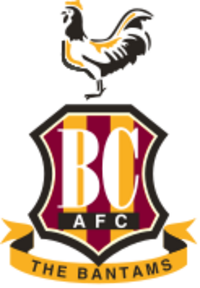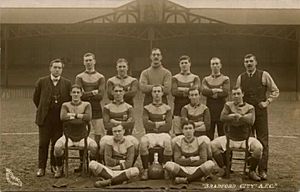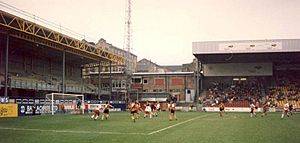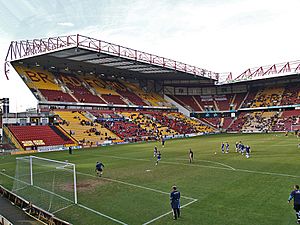Bradford City A.F.C. facts for kids
 |
||||
| Full name | Bradford City Association Football Club | |||
|---|---|---|---|---|
| Nickname(s) | The Bantams The Paraders The Citizens |
|||
| Founded | 1903 | |||
| Ground | Valley Parade | |||
| Capacity | 24,840 | |||
| Coordinates | 53°48′15″N 001°45′32″W / 53.80417°N 1.75889°W | |||
| Chairman | Stefan Rupp | |||
| Manager | Graham Alexander | |||
| League | League Two | |||
| 2018–19 | League One, 24th of 24 (relegated) | |||
|
||||
Bradford City Association Football Club is a professional football team from Bradford, West Yorkshire, England. The club is often called "The Bantams" and plays in League Two, which is the third level of English football. The team is currently managed by Graham Alexander.
Bradford City was started in 1903 and quickly joined the Football League Second Division. They won the Second Division title in 1907–08, moving up to the top league. Their biggest win was the 1911 FA Cup final, which is still their only major trophy. After some ups and downs, including winning the Third Division North title in 1928–29, they faced more challenges.
In the 1980s, Bradford City had a successful period. They earned promotion in 1981–82 and then won the Third Division title in 1984–85. Later, they reached the Premier League in 1998–99, returning to the top flight after 77 years. They even played in Europe, reaching the semi-finals of the UEFA Intertoto Cup in 2000–01.
The club's home ground is Valley Parade, which can hold 24,840 fans. On May 11, 1985, a tragic fire happened at the stadium, causing a great loss of life. Bradford City is the only professional football club in England that wears claret and amber colours. They have worn these colours throughout their history. Their main nickname is "The Bantams," which is also on their club crest. Bradford City has local rivalries with Huddersfield Town and Leeds United.
Contents
Club History: Key Moments
Bradford City was formed in 1903. This happened after meetings between James Whyte, a newspaper editor, and the Football Association. The Football League wanted to promote football in West Riding of Yorkshire, where rugby league was more popular. So, the new club was accepted into the Football League Second Division.
Four days later, the Manningham F.C. rugby league team decided to switch to football. Bradford City took over Manningham's claret and amber colours and their Valley Parade ground. The club played its first game on September 1, 1903, losing 2–0 to Grimsby Town. Their first home game attracted 11,000 fans.
Early Success and FA Cup Win
Peter O'Rourke became manager in November 1905. He led City to win the Second Division title in 1907–08, which meant they were promoted to the First Division. In their first season in the top league, they just avoided relegation.
In the 1910–11 season, City achieved their highest league finish, coming in 5th place. In the same season, they won the FA Cup. Captain Jimmy Speirs scored the winning goal in the final replay against Newcastle United. City kept 12 clean sheets in a row during their cup defense, but were eventually stopped by Barnsley.
Ups and Downs Through the Years
City stayed in the top league until 1922, when they were relegated with Manchester United. They struggled in the Second Division and were relegated again in 1926–27 to the Third Division (North). Peter O'Rourke returned and led City to promotion in 1928–29, scoring a record 128 goals.
After World War II, City often finished in the bottom half of the Third Division (North). In 1958–59, they were placed in the new national Third Division. They were relegated to the Fourth Division in 1962. In 1960–61, they famously beat First Division team Manchester United in the first League Cup season.
City earned promotions back to the third tier in 1969 and 1977, but were relegated again in 1972 and 1978.
The 1980s and the Valley Parade Fire
In May 1981, Roy McFarland became manager and led City to promotion in his first season. He then left for Derby County. Trevor Cherry took over and helped the team avoid relegation. The club faced financial problems but was saved by former chairmen.
In 1984–85, City won the Third Division title, returning to the second tier. However, this triumph was overshadowed by a terrible fire at Valley Parade during the final game of the season on May 11, 1985. The fire tragically killed 56 supporters.
Return to the Top and Recent History
City played their home games at other stadiums for 19 months while Valley Parade was rebuilt. The new ground opened in December 1986. In 1996, under chairman Geoffrey Richmond, City were promoted to Division One through the play-offs.
In 1998–99, under manager Paul Jewell, Bradford City earned promotion to the Premier League, returning to the top flight after 77 years. They avoided relegation on the last day of the next season with a 1–0 win over Liverpool. However, after Jewell left, the club faced financial difficulties and was relegated from the Premier League in 2001. They were relegated twice more in 2004 and 2007, returning to the fourth tier.
In January 2013, City made history by becoming the first fourth-tier club since 1962 to reach the League Cup final. They beat three Premier League teams on their way to the final, including Arsenal and Aston Villa. They lost 5–0 to Swansea City in the final at Wembley.
Just a few months later, on May 18, 2013, Bradford City returned to Wembley and won the League Two play-off final 3–0 against Northampton Town. This win secured their promotion to League One.
In January 2015, Bradford City caused a big upset by beating Premier League leaders Chelsea 4–2 away in the FA Cup. They then beat another Premier League team, Sunderland, 2–0 at home in the next round. They were eventually knocked out by Reading in the quarter-finals.
The club was relegated to League Two at the end of the 2018–19 season. In February 2022, Mark Hughes was appointed manager, but he left in October 2023. Graham Alexander became the new manager in November 2023. Bradford City was promoted to League One on the last day of the 2024–25 EFL season after beating Fleetwood Town.
Team Colours and Crest
Bradford City is the only professional football club in England that wears claret and amber. These colours were passed down from Manningham FC when Bradford City was formed in 1903. Manningham FC started using these colours in 1884.
The reason Manningham chose claret and amber is not fully known. However, these were the colours of The Prince of Wales's Own West Yorkshire Regiment, which was based near the club's ground. Since the 1985 fire, the club has used black on its kit as a way to remember the 56 supporters who died.
The club's crest has changed over the years. In 1974, it featured the club's initials. By 1981, a bantam bird was added to the crest, and "The Bantams" became the official nickname.
Club Nickname: The Bantams
Bradford City has had several nicknames. In their early days, they were sometimes called the "Robins" or "Wasps." Other names included the "Citizens" or "Paraders." However, the club is best known as "The Bantams."
The "Bantams" nickname likely became popular during World War I. At that time, the club's stadium, Valley Parade, was used to recruit soldiers for the West Yorkshire Regiment. Some of these groups were called "Bantams Battalions" because many of the recruits were shorter than average.
Home Ground: Valley Parade
Valley Parade was originally a quarry site. In 1886, Manningham RFC bought part of the land and built a ground with a capacity of 20,000. When Bradford City was formed in 1903, they took over Valley Parade. Their first home game there was on September 5, 1903, with 11,000 fans attending.
When the club was promoted to the First Division in 1908, the stadium was improved. Its capacity increased to 40,000. On March 11, 1911, Valley Parade saw its highest attendance of 39,146 for an FA Cup game against Burnley.
The stadium remained mostly the same until 1952. Parts of the Midland Road stand had to be rebuilt or removed over the years.

On May 11, 1985, a tragic fire occurred at Valley Parade, killing 56 supporters and injuring many more. The fire destroyed the main wooden stand very quickly. While the stadium was rebuilt, the club played its home games at other grounds. The new Valley Parade reopened on December 14, 1986.
Over the years, more improvements were made to Valley Parade. In 1991, the Bradford End was redeveloped. In 1996, a new stand was built on the Midland Road side. Before the club's promotion to the Premier League in 1999, the Kop stand was also rebuilt, increasing the capacity to 20,000. The main stand was also improved, bringing the total capacity to 24,840.
The stadium has had different names due to sponsorship deals. Since 2022, it has been known as the University of Bradford Stadium.
Club Supporters
Bradford City has worked to make football affordable for fans. In 2007, they offered season tickets for just £138, which was one of the cheapest in England. This led to 12,019 season tickets being sold. The club had the highest average attendance in Football League Two during the 2007–08 season.
For the 2015–16 season, the club offered season tickets for £149 for adults, with free admission for under-11s. This campaign was very successful, with over 18,000 tickets sold. They repeated this success in the 2016–17 season, selling over 17,000 tickets.
Bradford City has an official mascot named Billy Bantam. In September 2022, the club set a League Two record for season ticket sales with 14,190. On March 4, 2023, Bradford City set a new attendance record for Football League Two with 20,383 fans at a game against Colchester United. This record was broken again on May 8, 2023, with 22,576 supporters attending a home game against Leyton Orient.
Rivalries
Bradford City has a local rivalry with Bradford Park Avenue, known as the Bradford derby. They also have rivalries with Leeds United and Huddersfield Town, which are part of the West Yorkshire derby.
Fans also consider Burnley, Barnsley, and Oldham Athletic as rivals.
European Football Appearances
Bradford City has only played in European football once, in the 2000 UEFA Intertoto Cup.
| Season | Competition | Round | Opponents | 1st leg | 2nd leg | Aggregate |
|---|---|---|---|---|---|---|
| 2000 | UEFA Intertoto Cup | Second round | 3–1 | 4–1 | 7–2 | |
| Third round | 2–0 | 1–0 | 3–0 | |||
| Semi–finals | 0–1 | 0–3 | 0–4 |
Players
Current Squad
|
|
Player of the Year Awards
Team CaptainsThe following is a list of the official captains for Bradford City's first team.
Famous Former PlayersIn 2007, a book called The Legends of Bradford City was released. It featured biographies of 100 important players and staff members from the club's history. Club StaffCurrent Staff Members
Past ManagersYou can find a full list of all past managers for Bradford City by following the link above. Club Honours and RecordsLeague Achievements
Cup Achievements
Club Records
All records are from the Bradford City F.C. official website. SponsorsKit and Main SponsorsHere are the companies that have sponsored Bradford City's kits and main shirts over the years:
Stadium SponsorsThe Valley Parade stadium has also had different sponsors for its name:
See also
|






 In Spanish:
In Spanish: